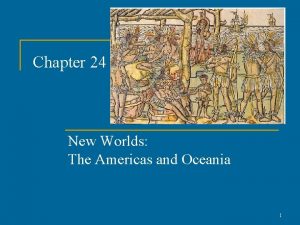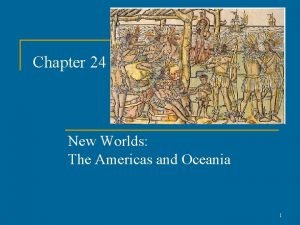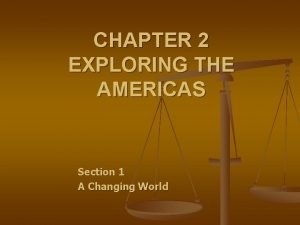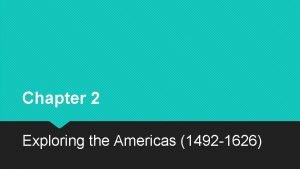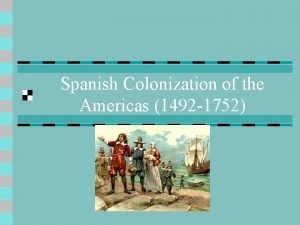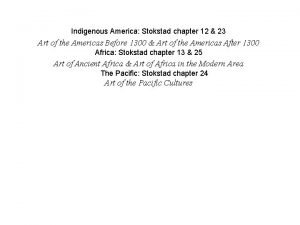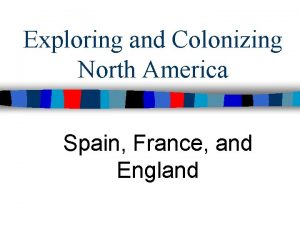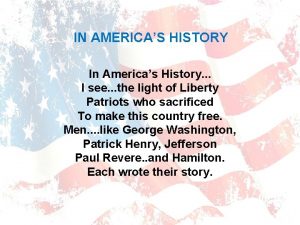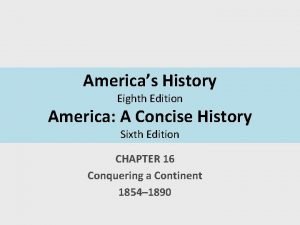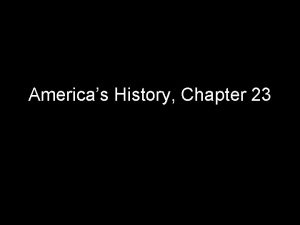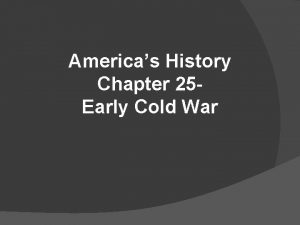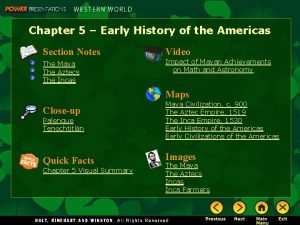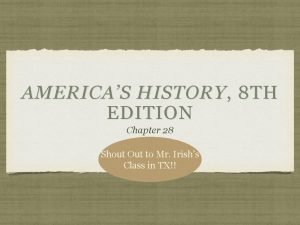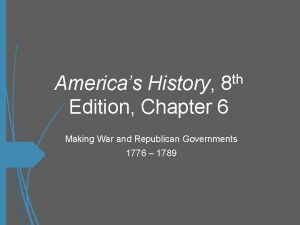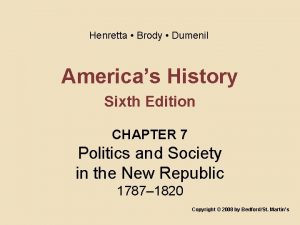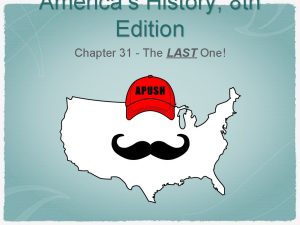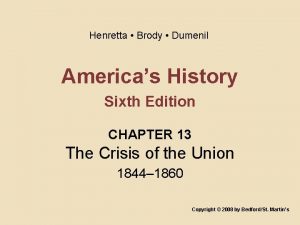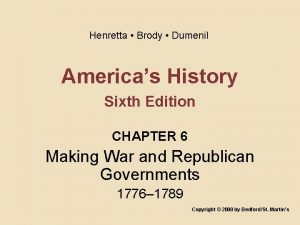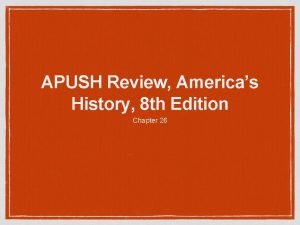Americas History Chapter 23 8 th Edition Early
















- Slides: 16

America’s History, Chapter 23 8 th Edition

Early Responses to the Depression, 1929 - 1932 Enter Herbert Hoover: Hoover believed volunteerism and hard work would alleviate the depression Hoover did not take the US off the gold standard Smoot-Hawley Tariff - significantly raised tariff rates - retaliatory rates from other countries Reconstruction Finance Corporation (RFC): Federal loans to businesses Spent too little $ too cautiously

Early Responses to the Depression, 1929 - 1932 Rising Discontent: Hoovervilles and Hoover blankets Bonus Army: 15, 000 WWI veterans demanded earlier bonus payment Hoover ordered the army disperse the Bonus Army - popularity decreased significantly The 1932 Election Hoover v. FDR defeated Hoover 472 - 59 Unemployment and bank failures continued throughout late 1932 and early 1933

The New Deal Arrives, 1933 - 1935 Roosevelt and the First 100 Days: Fireside chats - Presidential addresses via radio “Brains Trust” - group of unofficial advisers that helped draft legislation Frances Perkins - 1 st female cabinet member 100 Days - legislation that focused on 4 major areas: banks, agriculture, businesses, and unemployment

The New Deal Arrives, 1933 - 1935 Banking Reform: Bank Holiday - closing of banks, could not reopen until they proved to be sound (Emergency Banking Act) Glass-Steagall Act: created FDIC, insured bank deposits up to $2, 500 Agriculture and Manufacturing: Agricultural Adjustment Act (AAA): Sought to rectify overproduction of farm goods Paid farmers not to grow crops (benefitted large National Recovery Administration (NRA): Industries agreed on prices and production quotas Key Concept 7. 1, III, A. The liberalism of President Franklin Roosevelt’s New Deal drew on earlier progressive ideas and represented a multifaceted approach to both the causes and land owners, not of sharecroppers) effects the Great Depression, using government power to provide relief to the poor, stimulate recovery, and reform the American economy. Both the AAA and NRA were declared unconstitutional by the Supreme Court….

The New Deal Arrives, 1933 - 1935 Unemployment Relief: Federal Emergency Relief Administration (FERA) - provided federal $ to give to states for relief programs Public Works Administration (PWA): Construction projects Civil Works Administration (CWA): Provided 4 million jobs to Americans in the winter of 1933 - 1934 Construction projects - bridges, roads, etc. ) Civilian Conservation Corps (CCC): Outdoor work, conservation, planting trees, etc. Mostly young men, 18 - 24, sent $ back home to families Housing Crisis: 500, 000 families lost their homes Federal Housing Administration (FHA) Helped regulate interest rates for mortgages

The New Deal Arrives, 1933 - 1935 The New Deal Under Attack: Securities and Exchange Commission (SEC) Regulated the stock market, sought to prevent abuses Critics on the Right: Liberty League - criticized government spending National Association of Manufacturers: Key Concept 7. 1, III, B. Radical, union, and populist movements pushed Roosevelt toward more extensive reforms, even as conservatives in Congress and the Supreme Court sought to limit the New Deal’s scope. Used radio and other media to promote their anti-Roosevelt message Schechter Poultry v. US, and Butler v. US declared the NRA and AAA unconstitutional by the Supreme Court Critics on the Populist Left: Francis Townsend: Proposed giving $200 a month to seniors over 60 - helped influence Social Security Huey Long: “Share our Wealth”

The 2 nd New Deal………. The Welfare State Comes into Being 1 st New Deal - economic recovery, 2 nd New Deal - social justice and safety net The Wagner Act and Social Security: Since the NRA was declared unconstitutional, unions lost many rights Wagner Act - workers had the right to join unions, couldn’t be fired for joining union Social Security Act - provided pensions for retired workers, compensation for unemployed and disabled workers New Deal Liberalism: Classical liberalism - associated with free markets

The 2 nd New Deal………. From Reform to Stalemate The 1936 Election: Works Progress Administration (WPA) Employed over 8 million workers Construction on roads, bridges, etc. Republican Alfred Landon challenged FDR, lost election Court Battle and Economic Recession: In reaction to the S. C. declaring New Deal Programs unconstitutional, FDR sought to: Appoint a new justice for every judge over 70 (could appoint 6) This “court packing plan” was overwhelmingly rejected “Roosevelt Recession” - FDR cut back on spending due to an improved economy Keynesian economics - Government must spend $ in a depression to “prime the pump” and stimulate the economy

The New Deal’s Impact on Society A People’s Democracy Organized Labor: Union membership increased to 23% Congress of Industrial Organization (CIO) - organized all workers within an industry regardless of skill level Women and the New Deal: Gender inequities persisted Elanor Roosevelt: “Eyes and ears” of FDR, transformed the image of the First Lady Women were often paid less than men for same jobs CCC did not allow women to join

The New Deal’s Impact on Society African Americans Under the New Deal: Resettlement Administration - helped small farmers buy land African Americans began to overwhelmingly vote Democratic CCC segregated blacks Lynching persisted throughout the 1900 s Scottsboro Boys - 9 African Americans charged with raping 2 white women on a train, 8 sentenced to death, eventually death sentences were overturned AAA did not help sharecroppers (checks were given to land owners) Indian Policy: John Collier - commissioner of Bureau of Indian Affairs (BIA) Indian Reorganization Act (Indian New Deal): Reversed the assimilation policy of the Dawes Act Many Natives were given religious freedom and semi sovereign nation status

The New Deal’s Impact on Society Struggles in the West: Mexican Americans benefitted from the WPA and CCC Most Chinese were excluded from New Deal Programs Reshaping the Environment FDR sought to have land benefit the needs of humans The Dust Bowl Impacted mostly the Great Plains region Over-cultivation affected farmland “Okies” fled to California - The Grapes of Wrath Dorothea Lange

The New Deal’s Impact on Society Tennessee Valley Authority: Focused on flood control, electricity development, etc. Provided a significant amount of electricity to farms, homes, and factories Rural Electrification Administration: Provided electricity to rural areas Grand Coulee Columbia River, Washington Largest electricity producer in the world The New Deal and the Arts Over 20, 000 Artists, musicians, and writers were employed

The New Deal’s Impact on Society Legacies of the New Deal Key Concept 7. 1, III, C. Although the New Deal did not completely overcome the Depression, it left a legacy of reforms and agencies that endeavored to make society and individuals more secure, and it helped foster a long-term political realignment in which many ethnic groups, African Americans, and working-class communities identified with the Democratic Party. Millions paid taxes into Social Security 1/3 of the population received government assistance New Deal was criticized by both the Right and Left **Change in voting patterns**: Unions, blacks, and many immigrants predominantly voted Democratic

Quick Recap Bonus Army Hoover’s vs. FDR’s response to the Depression New Deal Programs Critics of the Great Depression (Right, Left, Supreme Court) New Deal’s impact on women, African Americans, and Native Americans TVA Voting Patterns

See You Back Here For Chapter 24! Thanks for Watching Please subscribe, share with others Check out all my videos related to the new curriculum Best of luck on all your tests!
 Ap world history chapter 20 the americas and oceania
Ap world history chapter 20 the americas and oceania Ib history paper 1 rights and protest past papers
Ib history paper 1 rights and protest past papers Chapter 24 new worlds the americas and oceania
Chapter 24 new worlds the americas and oceania New worlds the americas and oceania
New worlds the americas and oceania New worlds the americas and oceania
New worlds the americas and oceania Chapter 10 global cuisine 1 the americas
Chapter 10 global cuisine 1 the americas Chapter 2 exploring the americas study guide
Chapter 2 exploring the americas study guide What did amerigo vespucci explore
What did amerigo vespucci explore Chapter 16 people and empires in the americas
Chapter 16 people and empires in the americas Using mis (10th edition) 10th edition
Using mis (10th edition) 10th edition Using mis 10th edition
Using mis 10th edition Early cpr and early defibrillation can: *
Early cpr and early defibrillation can: * Spanish caste system in the americas
Spanish caste system in the americas Spanish colonization of the americas
Spanish colonization of the americas Soroptimist international of the americas
Soroptimist international of the americas Art of the americas before 1300
Art of the americas before 1300 When did britain colonize america
When did britain colonize america


